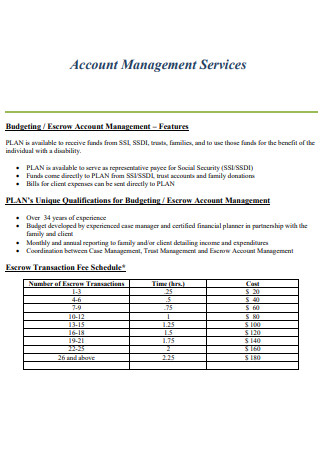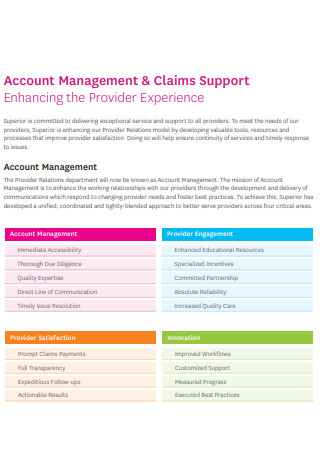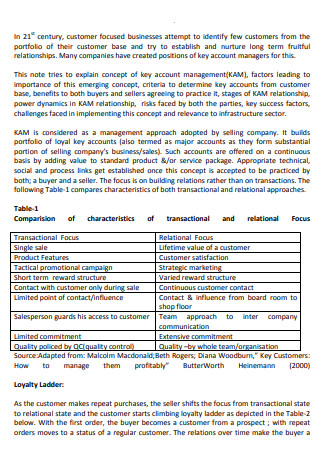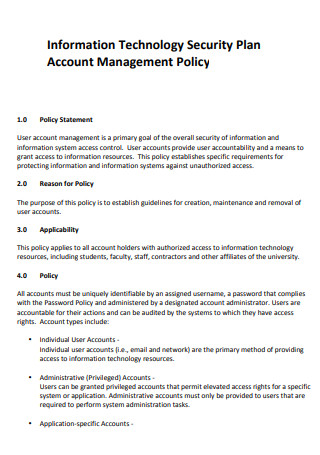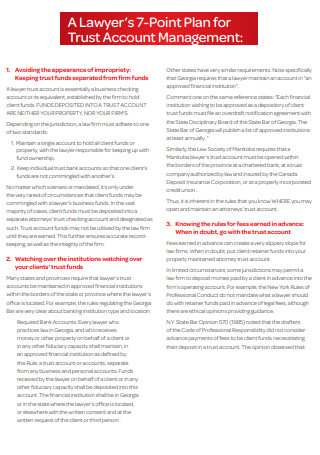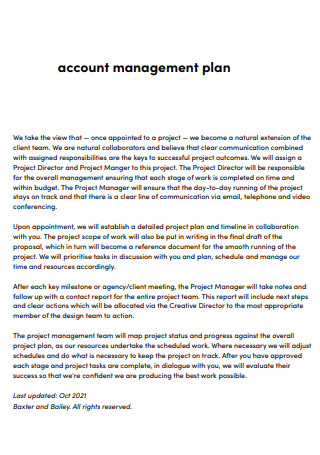5+ SAMPLE Account Management Plan
FREE Account Management Plan s to Download
5+ SAMPLE Account Management Plan
What Is an Account Management Plan?
What Is the Importance of Account Management Plan?
What Are the Best Practices of Account Management Plan?
How to Improve an Account Management Strategy?
FAQs
What Makes a Good Account Management Plan?
What Is the Role of Account Planner?
What Are the Roles and Responsibilities of an Account Manager?
What Is an Account Management Plan?
An Account Management Plan focuses on building long-term mutually beneficial partnerships with key customers and clients. Through the in-depth research and assessment, strategic account managers find opportunities to drive value for their partners by identifying problems, offering creative solutions, and leveraging partnerships to move both organizations toward their strategic goals. A formal account management plan can:
- Increase profitability
- Foster customer loyalty
- Stimulate growth
- Drive innovative and scalable service solutions
Far apart from a sales program—which focuses on short-term selling cycles and customer acquisition—an account management plan goes a step further to improve and develop deeper relationships with a small number of core customers over time. In short, sales are all about the present. Strategic account management is about the future. While the gains may not be drastic, strategic accounts are an essential part of an organization’s long-term success and profitability.
What Is the Importance of Account Management Plan?
The account management plan is very important because it is the strategic approach of identifying and nurturing your accounts that make high-value repeat purchases to maintain mutually beneficial relationships. It often creates opportunities to explore and build unique partnerships with your clients while growing both of your businesses. Account management aims to retain existing business operations and expand on profitable opportunities. Industries that depend on supplying raw material to manufacturers and sellers, such as pharmaceutical, health care, advertisement, consulting and many other business-to-business (B2B) transaction-based organizations, may rely on key account management as a company strategy. With this, account management plan efforts can maximize the long-term benefits of strategic partnerships. Moreover, account management plans are important because they can maximize sales by volume and size while boosting client-business loyalty. Below are some advantages that directly result from strategic account management plans:
Increase Customer Loyalty
Loyal customers may be more likely to grow their business and profits alongside yours. If a client does business with you specifically over months or years, it may boost your market credibility and chances of future sales success. Giving individual attention to a customer or client may improve customer loyalty and retention. Key accounts may be some of your most important customers and with this, they often appreciate updates, discounts or knowledge of changes in your company on a priority basis.
Better Revenue
This is may help to improve the bottom line of your company by bringing in higher revenue. An increase in customer loyalty because of the emphasis on forming and maintaining positive relationships could result in better ratings in terms of customer or client satisfaction.
Competitive Advantage
This could provide firms or businesses with a sizable advantage in an increasingly competitive market. By establishing, nurturing and growing a long-term relationship with a key account, you can scale both your economic relationship and scope of work with them.
What Are the Best Practices of Account Management Plan?
An effective Account Management program is not something you stumble upon. The most successful organizations rely on formal, measurable, repeatable processes to develop and maintain their most valuable customer relationships. Whether you already have a process in place or plan to implement a new strategic account program, use these best practices to put your organization ahead of the curve.
How to Improve an Account Management Strategy?
Consider following these steps to develop and improve your strategy with key accounts:
Step 1: Identify Key Accounts
It is important to distinguish between your key accounts and your strategic accounts while trying to pinpoint your highest contributing clients. A key account refers to a relationship of mutual respect and long-term engagement, while a strategic account is a time-sensitive asset that may or may not grow to be a key account. Consider researching your client’s business plan, financial condition and willingness to grow alongside you in the future. If you feel that losing a client may generate an unmissable revenue gap, that account is likely to be a key account.
Step 2: Increase the Number of Point of Contacts
You may increase your point of contacts or POCs in your key accounts to gain an advantage and emphasize how much each of your alliances means to your company. Many influencers in your clients’ business ecosystem may have a considerable impact on important decisions. A well-built sales strategy could include activities like reaching out to every one of these key influencers and discussing your business propositions with them. Creating a map of these individuals within the company hierarchy may help you identify important decision-makers that could improve the overall business relationship.
Step 3: Add Value
Adding value to your client relationships may help you maintain key accounts. You can add value to your client relationships in various ways, such as contributing to the profitability of your accounts, reducing costs, identifying or reducing risk for your clients and maintaining a sustainable relationship with the influential individuals within your accounts. Insightful value addition can foster the goal of a key account management plan—long-term, mutually beneficial business growth.
FAQs
What Makes a Good Account Management Plan?
Strategic account managers should be both analytical and personable. This means, they need to build a good rapport with customers, think strategically about partnership opportunities and solutions, collaborate and communicate with high-level stakeholders and decision-makers, and lead a cross-functional team.
What Is the Role of Account Planner?
The role of an Account Planner is to drive the general strategic direction of creative campaigns. They also make sure that the creative team’s work is focused strategically and is within brand guidelines as well.
What Are the Roles and Responsibilities of an Account Manager?
An Account Manager is in charge of ensuring or securing each department meets the needs of their clients and customers. They handle customer complaints, find solutions to their issues, and maintain a positive relationship between both parties for future business ventures.
Strategic account management plan is absolutely complex. With so many moving parts, it is easy for data, insights, or people to fall through the cracks. Hence, key accounts represent the most valuable customers, so you can’t afford to drop the ball.
Generally, account planning and account-based marketing take time, but the rewards are undoubtedly massive. Putting in place an account planning process in your sales team will help you nurture your current partnerships, increase customer retention, and boost repeat sales, empowering your business to grow better and expand later.

